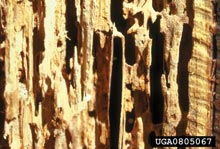
R. Werner, USDA Forest Service
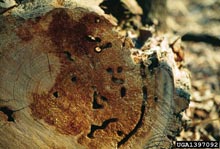
Joseph O’Brien, USDA Forest Service
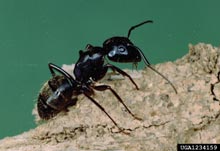
Clemson University, USDA Cooperative Extension Slide Series
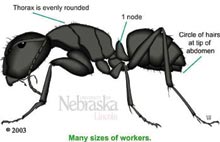
University of Nebraska-Lincoln Extension: http://lancaster.unl.edu/pest/
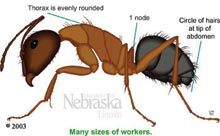
University of Nebraska-Lincoln Extension: http://lancaster.unl.edu/pest/
Carpenter Ants
General Description
The typical adult, known as a “worker” ant, is black, wingless and varies from one-fourth of an inch to one-half of an inch in length. The size and color of carpenter ants vary considerably between species and even between ants from the samecolony, so these features cannot be relied upon for identification. Instead, look first for the carpenter ant’s smoothly rounded thorax (viewed from the side) and single node (the small triangular connection between the abdomen and thorax; some ants have two nodes). Carpenter ant nests consist of smooth, clean tunnels and excavations in wood that run with or against the grain. In contrast, subterranean termite tunnels are lined with a mud-like material and always run in the same direction as the wood’s grain. A carpenter ant colony is often composed of a series of nests. The main nest, orparentnest, is usually located outdoors, often in woodpiles, logs, stumps, or trees, sometimes several feet above the ground. The nest contains the queen, some workers, larvae and pupae. It may be joined by sub-nests, orsatellitenests, containing workers, and older larvae and pupae.
Carpenter ants are fast moving and stop only to feed or share food with other ants. They are most active at night. Workers emerge from the nest about 15 minutes after sundown. Like other ants, they follow chemical trails in search of food, sometimes hundreds of feet from the nest, and often create permanent, well-beaten trails, like cow paths through the grass. A colony may use the same path from year to year. Each year, carpenter ants become active in the spring (March to April) and remain so through early fall (September to October). A mature carpenter ant colony usually releases reproductive individuals (winged swarmers) in the springtime.
General Control
Methods of sanitation and exclusion can be employed to help prevent carpenter ant home invasions or to supplement control of existing infestations. Carpenter ants require wood and moisture, so efforts should be made to reduce these around the home. Stumps, logs and woodpiles should be eliminated or moved as far away from the structure as is practical. Openings into the structure—that is, cracks in the foundation, gaps around doors and windows, and spaces where utility lines penetrate the structure—should be sealed. Also, correct moisture problems that occur from grades sloping toward the foundation, clogged gutters, leaky plumbing and faulty seals around chimneys, skylights, doors and windows. Overhanging tree branches should be cut back to prevent them from contacting the structure and providing an easy access route for ants.
Locating the nest(s) is key to carpenter ant control. Applying pesticides around an infested structure’s foundation, or into the open space in an attic, usually provides little or no control and unnecessarily exposes non-targeted organisms (including people) to pesticides. For permanent control, nests must be treated directly. This may require drilling into voids in walls, doors, window frames, etc., to allow dust or liquid insecticide injection into the nest. Bait formulations also are available for carpenter ant control, though they may be a slower and less effective method compared to finding and treating the nests.









